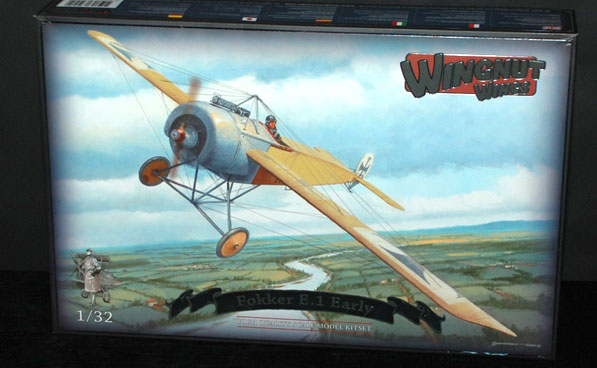
Kit Reference: 32021
Price around USD $69.00 (around £46.00 GBP)
Review by Geoff Coughlin (Nov 2013)
Our thanks to Wingnut Wings for supplying our review sample. Get this great kit and all the other superb kits in the WW range here now at: www.wingnutwings.com
We have multiple builds of Wingnut Wings kits… just check out your Wingnut Wings Finished Now area in SMN.
Here’s a nice bit of inspiration…
Background from WW
The legendary Fokker Eindecker, armed with a machine gun synchronized to fire through the propeller, made its 1st kill on 1st August 1915. It was an 80hp Oberursel U.0 (license built 80hp Gnome) powered wing warping Fokker E.1 flown by Max Immelmann that also marked the beginning of the “Fokker scourge”. Inspired by the capture on 18 April 1915 of Roland Garros and his Morane-Saulnier Type L Parasol fitted with a forward firing machine gun (using armoured deflector plates to protected the propeller from ‘serious’ bullet damage) the Germans set about coming up with their own version. Legendarily, the 25 year old Anthony Fokker created his own interrupter gear in just 48 hours after being inspired by the capture of Garros, but this is undoubtedly a myth.
A mechanical interrupter gear had been patented in 1913 by Hans Schneider of LVG but it was not until Fokker perfected it, or a similarly inspired design, that it worked sufficiently well to be employed in combat. Lawsuits filed by Schneider against Fokker continued up until September 1933.
Fokker’s unarmed 80hp and 100hp reconnaissance A type Eindeckers (inspired by a successful pre-war wing warping Morane-Saulnier design but with a welded steel tube frame fuselage) provided the airframe for further development and E.1 (armed Eindecker 80hp) types started shipping to front line units in June 1915. Although initially armed with a Parabellum LMG 14, which proved less than satisfactory, very soon into production they were fitted with the lMG 08 ‘Spandau’. The 100hp Oberursel U.1 (license built 100hp Gnome Monosoupape) powered E.II was developed concurrently with the E.1 and started entering service in July 1915. The E.III (externally identical to late production E.II) followed in August 1915 and from about October updated E.III started appearing with internal ammunition storage and a wing mounted compass. The 160hp Oberursel U.III powered Fokker E.IV, initially fitted with 3 lMG 08 machine guns (which proved to be 1 gun to many) first appeared in September 1915 but did not arrive at the front in larger numbers until March-April 1916. By this time the appearance of the highly manoeuvrable French Nieuport 11 and British DH.2 had marked the beginning of the end of the “Fokker scourge”, effectively rendering the wing warping German monoplanes obsolete. Most Eindeckers had been withdrawn from front line service by December 1916.
Any history here is of necessity very brief so we recommend that you seek out the references mentioned below for the better understanding of the various Fokker Eindeckers, but we do so with the following caution; considerable confusion exists about these important aircraft (in no small part because of incorrect or conflicting Idflieg and Fokker factory records). Because of this we highly recommend you treat published drawings & specifications with a great deal of scepticism. We feel that Josef Scott’s new Windsock Datafile Fokker Eindecker Compendiums published in September 2012 will go a long way towards clearing up much of this confusion.
It appears that Fokker Eindecker steel tube framework and fittings were painted in grey-green while all aluminium panels and cowls remained unpainted and were given a ‘squiggly turned’ finish. Despite conventional wisdom, photographic evidence indicates that no Fokker Eindeckers were factory finished in Clear Doped Linen (CDL). Contemporary allied combat reports record Fokker Eindecker colours such as “dark brown”, “dark brown wings on the upper side”, “grey”, “straw yellow”, “white”, “black” and “butcher blue”. A French report mentions that “the fabric of the Fokker wings was generally beige in 1916” while capture reports of later production E.III 196/16 and E.III 210/16 simply mention “beige”. It is possible that “beige” and “straw yellow” are actually same colour and “white” and “black” may refer to misidentified Pfalz Eindeckers. It would appear that the linen covering was dyed, possibly before being fitted to the aircraft, or colour doped after being attached but before being finished with clear shrinking dope and varnish. Most Fokker Eindeckers exhibit heavy castor oil staining along their fuselages which soaked through the fabric from the inside, considerably darkening the coloured fabric.